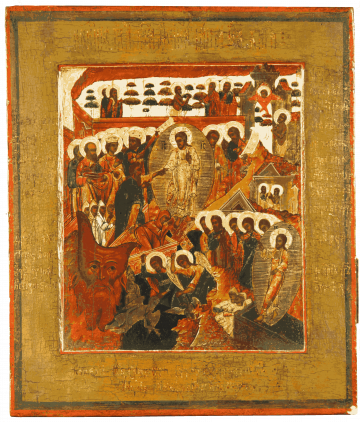Descent into the Underworld
(Russia; nineteenth century)
Russia; nineteenth century; 30.7 x 26.2 cm
Feast: Sunday Passover and the 40-day period after the feast
Description of the icon
The author of this icon was in all probability inspired by the icon from the Monastery of Christ the Saviour in the village of Chora, which is currently located in the Edirnekapi area of Istanbul. This church was built in 1081. A mosaic decoration was realized in the interior at the beginning of the fourteenth century, from which, among other things, the icon Descent into the Underworld has been preserved. It is located above the prothesis (πρόθεσις), in the left part of the sanctuary, where the priest prepares sacrificial offerings for the celebration of the liturgy.
The icon expresses the essence of the Christian faith, the resurrection of Jesus Christ. The resurrected Christ dressed in a golden robe is in the centre of the icon in a mandorla. He breaks the gates of hell and frees from captivity the grandparents Adam and Eve, St. John the Baptist, kings, prophets and all the righteous of the Old Testament. Through the resurrection of Christ, the gates of paradise, symbolically displayed at the top of the icon, were opened to the people. The entrance to the garden of paradise is guarded by a fiery cherub. He lets the liberated into the paradise where Enoch and Elijah are waiting. The first to arrive is the repentant thief who Christ spoke to on the cross: “Assuredly, I say to you, today you will be with Me in Paradise.” (Luke 23:43) An entire line of the Old Testament righteous proceed after him. The face of Hades, a personified hell from whose oesophagus (οἰσοφάγος) the dead righteous emerge, is in the lower part on the left. Two angels of the Lord drive the demons back into the underworld. The tomb from which the risen Christ emerges, together with the hosts of saints which corresponds to the words of the Scripture, is at the bottom right: “the graves were opened; and many bodies of the saints who had fallen asleep were raised.” (Matthew 27:52)
The icon also includes the scene of the resurrection of Lazarus, placed above Christ, as a symbolic prefiguration of Christ's resurrection. By connecting these events, the iconographer wanted to point out the divine power of Christ, after whose words his friend Lazarus rose from the dead and then He also could rise from the dead. This fact is also confirmed by Stichira in the evening of Palm Sunday: “Lord, as a prefigure of your glorious resurrection, you lifted your friend Lazarus from the grave. By your command you gave life to the one who rested in the sleep of death for four days.”


